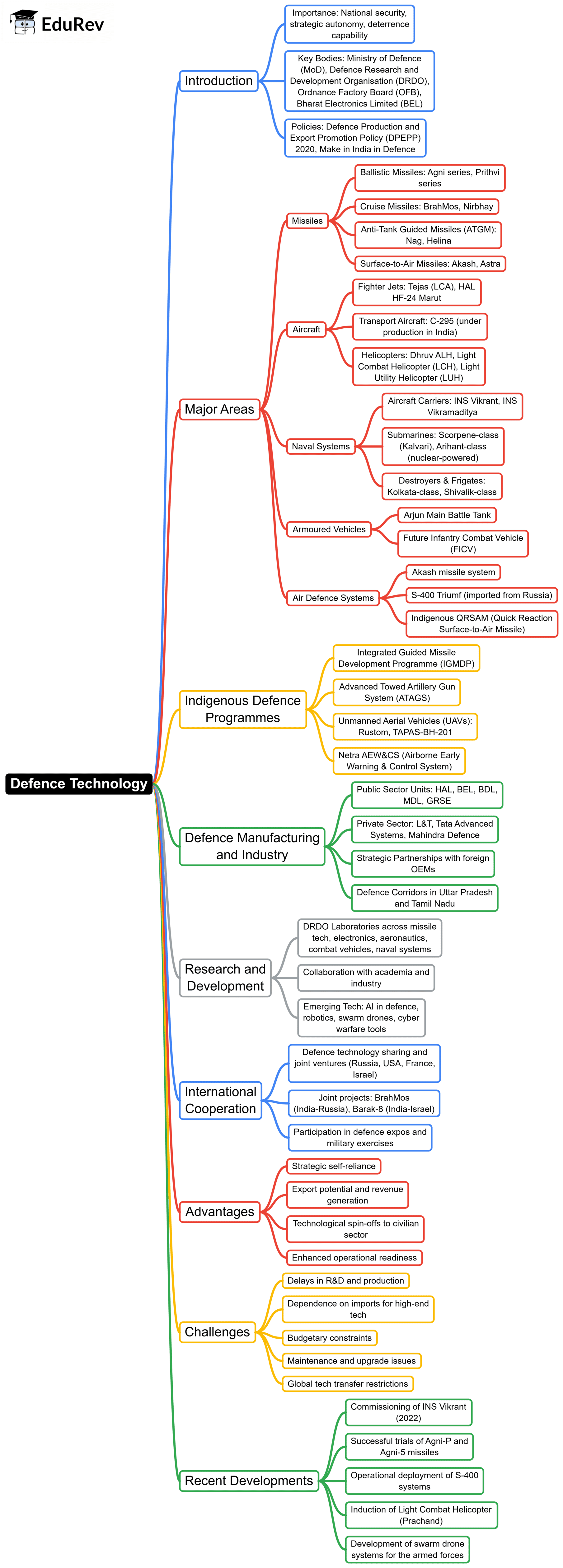UPSC Exam > UPSC Notes > Science & Technology for UPSC CSE > Mind Map: Defence Technology
Mind Map: Defence Technology | Science & Technology for UPSC CSE PDF Download

The document Mind Map: Defence Technology | Science & Technology for UPSC CSE is a part of the UPSC Course Science & Technology for UPSC CSE.
All you need of UPSC at this link: UPSC
|
90 videos|490 docs|209 tests
|
FAQs on Mind Map: Defence Technology - Science & Technology for UPSC CSE
| 1. What are the key components of modern defence technology? |  |
Ans.Modern defence technology encompasses a wide range of components including advanced weaponry, surveillance systems, communication technologies, and cyber capabilities. Key areas include unmanned aerial vehicles (UAVs), missile systems, radar technology, and information warfare strategies. Additionally, the integration of artificial intelligence and machine learning is increasingly playing a crucial role in enhancing defence capabilities.
| 2. How has defence technology evolved over the decades? |  |
Ans.Defence technology has undergone significant evolution, particularly after major conflicts such as the World Wars and the Cold War. Developments have included the transition from conventional warfare to asymmetric warfare, advancements in precision-guided munitions, and the growing importance of cyber warfare. The Cold War era saw the rise of nuclear technology, while recent years have highlighted the importance of unmanned systems and cyber defence.
| 3. What role does research and development play in defence technology? |  |
Ans.Research and development (R&D) are vital for advancing defence technology. Governments and military organizations invest heavily in R&D to innovate and enhance existing systems. This includes developing new materials, improving weapon efficiency, and creating advanced simulation technologies for training. Collaborations between public and private sectors are also common to promote technological advancements.
| 4. How does international cooperation impact defence technology? |  |
Ans.International cooperation significantly impacts defence technology through joint ventures, technology transfers, and collaborative research efforts. Countries often partner to share knowledge and resources, which can lead to enhanced security and technological capabilities. Alliances such as NATO exemplify how member countries collaborate on defence projects to improve collective security and operational effectiveness.
| 5. What are the ethical considerations surrounding defence technology? |  |
Ans.Ethical considerations surrounding defence technology include the implications of autonomous weapons, the potential for civilian casualties, and the impact of surveillance technologies on privacy. Debates focus on the responsibility of nations to regulate emerging technologies and the moral ramifications of using advanced technologies in warfare. Ensuring compliance with international humanitarian law is also a critical aspect of these discussions.
Related Searches
















